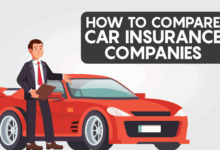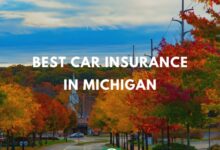Car Insurance Near Me: Finding the Best Coverage
Car insurance near me—a simple search query with far-reaching implications. Finding the right car insurance can feel overwhelming, juggling factors like price, coverage, and company reputation. This exploration delves into the complexities of this common search, examining user needs, competitive landscapes, and strategies for finding the ideal policy. We’ll navigate the world of local search results, marketing tactics, and customer experience to provide a comprehensive understanding of the car insurance market.
Understanding the motivations behind searching “car insurance near me” is crucial. Users might be seeking immediate coverage following an accident, shopping for a new policy, or simply comparing prices from local providers. Their needs vary greatly, from budget-conscious drivers prioritizing affordability to those seeking comprehensive protection with extensive benefits. This variance necessitates a nuanced approach to understanding the market and meeting diverse customer expectations.
Understanding User Search Intent
Understanding the motivations behind a user searching for “car insurance near me” is crucial for providing relevant and helpful information. This seemingly simple search query actually masks a variety of underlying needs and circumstances. The intent is rarely just about finding the closest insurer; it’s about addressing a specific need or solving a problem.
The search “car insurance near me” reflects a user’s immediate need for car insurance, often coupled with a desire for convenience and potentially cost-effectiveness. The proximity element highlights the importance of accessibility and potentially personalized service.
User Motivations and Scenarios
The primary motivation behind this search is often tied to a specific event or circumstance. For example, a user might be searching because they just bought a new car and need insurance immediately. Another scenario might involve a user whose current policy is expiring and they are looking for a better deal locally. A third scenario could be that a user has been in an accident and needs to find coverage quickly. These situations all share a common thread: the need for immediate action and local options.
User Needs Based on Search Query
Users searching for “car insurance near me” have diverse needs beyond simple geographical proximity. These needs can be categorized into several key areas:
- Price Comparison: Users often want to compare quotes from multiple insurers in their area to find the most affordable option. This is particularly true for budget-conscious individuals or those seeking the best value for their money. For instance, a young driver might prioritize affordability over comprehensive coverage, while an older driver with a more expensive vehicle might focus on finding a balance between price and coverage levels.
- Policy Coverage Options: The search reflects a need to understand different policy options and coverage levels. Users might be seeking specific types of coverage, such as liability, collision, or comprehensive, and want to compare what’s offered by local providers. A user with a new car might prioritize comprehensive coverage to protect their investment, while someone with an older car might opt for a less expensive liability-only policy.
- Convenience and Accessibility: The “near me” aspect underscores the importance of convenience. Users want insurers with easily accessible locations, convenient online platforms, or flexible appointment scheduling. For example, a user with a busy work schedule might prioritize an insurer with online quote and application capabilities, while someone who prefers personal interaction might seek an insurer with a nearby office.
- Reputation and Reviews: Users often look for reputable insurers with positive reviews from other customers. They want assurance that they are choosing a reliable company with a good track record of customer service and claims handling. A user might check online reviews before choosing an insurer, comparing customer experiences and ratings to inform their decision.
Local Search Results Analysis
Understanding the structure of local search results for “car insurance near me” is crucial for both consumers and insurance providers. The results page typically presents a mix of organic listings and paid advertisements, prioritized to display the most relevant options based on the user’s location and search history. This blend of information aims to provide a comprehensive overview of local car insurance options.
The typical structure consists of a map displaying nearby insurance providers, followed by a list of organic search results. These results often include a mix of direct insurance providers, independent insurance agents, and online comparison platforms. Prominent display of star ratings and reviews alongside business details (address, phone number, website) is common. Paid advertisements, clearly marked as such, usually appear at the top and sometimes interspersed within the organic results.
Types of Businesses in Local Search Results
The variety of businesses appearing in the local search results reflects the diverse ways consumers can obtain car insurance. These typically include:
- Direct Insurance Providers: Large national companies like Geico, State Farm, Progressive, and Allstate often appear prominently, showcasing their brand recognition and extensive network. Their listings typically highlight specific local agents or offices.
- Independent Insurance Agents: These agents represent multiple insurance companies, allowing them to offer a wider range of choices and potentially more competitive rates. Their listings emphasize their independence and ability to compare quotes from various providers.
- Online Comparison Platforms: Websites like The Zebra, NerdWallet, and Policygenius appear frequently, providing a convenient way for consumers to compare quotes from different insurers. Their listings highlight their ease of use and comprehensive comparison capabilities.
- Local Insurance Brokers: Smaller, localized brokers may also appear, focusing on building personal relationships with clients and providing specialized insurance services within a specific geographic area.
Factors Influencing Local Insurance Provider Ranking
Several key factors significantly impact the ranking of local insurance providers in search results. These factors combine to create a holistic assessment of relevance and authority.
- On-Page Optimization: This includes using relevant keywords in website content, optimizing website speed and mobile-friendliness, and ensuring accurate and consistent NAP (Name, Address, Phone number) data across online platforms. A well-structured website with detailed information about services and local area coverage significantly improves ranking.
- Local Citations: Consistent and accurate listings on online directories like Yelp, Google My Business, and other relevant platforms are crucial. These citations confirm the business’s existence and location, boosting local search visibility.
- Online Reviews and Ratings: Positive reviews and high ratings on various platforms play a vital role. Consumers rely heavily on reviews when choosing an insurance provider, and search algorithms reflect this by prioritizing businesses with strong reputations.
- Google My Business Profile Optimization: A complete and optimized Google My Business profile, including high-quality photos, detailed business information, and regular updates, is essential for high local search ranking. This directly impacts visibility on Google Maps and local search results.
- Backlinks from Relevant Websites: Links from reputable websites within the insurance or local business community can enhance search engine authority and boost ranking. High-quality backlinks from trusted sources are highly valued by search algorithms.
Competitive Landscape
The car insurance market is fiercely competitive, with established national brands vying for market share alongside smaller, regional players. Understanding the marketing strategies and unique selling propositions of these companies is crucial for a new entrant to effectively position itself. This analysis will compare and contrast the approaches of leading providers and propose a marketing campaign for a hypothetical new company.
Top-ranking insurance providers generally employ a multi-pronged marketing approach, combining digital advertising (SEO, SEM, social media), traditional media (TV, radio), and strategic partnerships. Their marketing messages often emphasize price competitiveness, bundled services, and customer experience. However, the specific emphasis varies considerably.
Marketing Strategies of Top-Ranking Providers
National brands like Geico and Progressive are known for their humorous and memorable advertising campaigns, often utilizing catchy jingles and celebrity endorsements. Their digital strategies are robust, with strong SEO presence and targeted online advertising. In contrast, companies like State Farm and Allstate often focus on building brand trust and long-term customer relationships through a combination of traditional advertising and local agency networks. These latter companies may emphasize community involvement and personalized service as differentiators.
Unique Selling Propositions of Different Insurance Companies
Each company attempts to carve out a unique niche within the market. Geico’s focus is often on low prices, while Progressive emphasizes its Name Your Price® tool, offering customers more control over their premium. State Farm and Allstate leverage their extensive agent networks and long-standing brand reputation to build trust and loyalty. Smaller, regional companies may compete by offering hyper-localized services and personalized attention, catering to the specific needs of their community.
Hypothetical Marketing Campaign for a New Insurance Provider
A new insurance provider could differentiate itself by focusing on a specific underserved market segment or offering a unique value proposition. For example, a campaign could target environmentally conscious drivers by offering discounts for electric vehicle owners or promoting sustainable practices. The campaign could use a combination of digital marketing (targeted social media ads, influencer partnerships, search engine optimization) and community engagement (sponsoring local events, partnering with environmental organizations). The messaging should emphasize the company’s commitment to sustainability and its competitive pricing, while highlighting the personalized service it provides.
For instance, the campaign could feature a series of short, engaging videos showcasing the company’s commitment to sustainability and its friendly, helpful customer service team. These videos could be shared across various social media platforms and embedded on the company’s website. Furthermore, the campaign could include targeted online advertising focusing on keywords related to eco-friendly driving and affordable car insurance. This multi-channel approach would maximize reach and brand awareness while targeting a specific demographic with a compelling value proposition.
Information Presentation
Presenting car insurance information clearly and concisely is crucial for helping potential customers make informed decisions. Effective presentation involves using various formats to cater to different preferences and comprehension levels. This section will demonstrate several methods for showcasing key details regarding car insurance plans.
Car Insurance Options Comparison Table
A comparison table allows for a quick overview of different insurance options. This is particularly helpful when comparing price points and coverage levels across various providers.
| Company | Price (Annual) | Coverage | Deductible |
|---|---|---|---|
| InsureCo | $1200 | Liability, Collision, Comprehensive | $500 |
| SafeDrive | $1000 | Liability, Collision | $1000 |
| AutoProtect | $1500 | Liability, Collision, Comprehensive, Uninsured Motorist | $250 |
| RoadGuard | $950 | Liability | $1000 |
Features of Three Car Insurance Plans
Understanding the specific features of each plan is essential. The following outlines the key benefits of three example plans.
The following bullet points detail the features of three distinct car insurance plans, highlighting their unique selling propositions.
- Plan A: Basic Coverage
- Liability coverage only.
- Lower premiums.
- Suitable for drivers with older vehicles or limited budgets.
- Plan B: Comprehensive Coverage
- Liability, collision, and comprehensive coverage.
- Higher premiums than Plan A.
- Offers greater protection against various risks.
- Plan C: Premium Coverage with Added Benefits
- Includes all features of Plan B.
- Adds roadside assistance and rental car reimbursement.
- Highest premiums but provides extensive coverage and convenience.
Key Information Presentation Using Blockquotes
Blockquotes are effective for emphasizing crucial policy details or highlighting important terms and conditions.
Using blockquotes to highlight important information improves readability and emphasizes key details.
This policy covers damages to your vehicle caused by collision with another vehicle or object. Exclusions may apply. Please refer to the full policy document for complete details.
Your annual premium is subject to change based on driving record, claims history, and other factors. A detailed breakdown of your premium is available upon request.
Uninsured/Underinsured Motorist coverage protects you in the event of an accident caused by a driver without adequate insurance. This coverage is optional but highly recommended.
Visual Communication
Effective visual communication is crucial for attracting and engaging potential customers in the competitive car insurance market. A well-designed infographic and a visually appealing website landing page can significantly improve lead generation and conversion rates by conveying complex information clearly and concisely. This section details the design and implementation of such visual elements.
Infographic Illustrating Factors Influencing Car Insurance Costs
This infographic uses a combination of bar charts, pie charts, and icons to visually represent the key factors affecting car insurance premiums. The dominant visual element is a large central bar chart showing the relative contribution of various factors – driving history (including accidents and violations), vehicle type and age, location (zip code), age and gender of the driver, and coverage level – to the overall cost. Each bar is color-coded for easy comparison, and the percentage contribution of each factor is clearly labeled. A smaller pie chart, positioned alongside the bar chart, breaks down the average cost distribution across different coverage types (liability, collision, comprehensive). Finally, relevant icons (e.g., a car, a speedometer, a house) are used throughout to add visual interest and reinforce the meaning of the data. This layered approach allows for a comprehensive yet easily digestible understanding of the cost components. For example, a taller bar representing “Driving History” immediately communicates its significant impact on premiums. The color-coding enhances readability and allows for quick identification of the most impactful factors.
Visually Appealing Website Landing Page for “Car Insurance Near Me” Searches
The landing page for users searching “car insurance near me” should prioritize clarity, convenience, and a strong call to action. The design employs a clean and modern layout with high-quality images of diverse people and families. A prominent headline, such as “Get a Free Car Insurance Quote in [City/Region]”, immediately addresses the user’s search query. Below the headline, a concise and easily scannable description highlights the key benefits of choosing this insurance provider (e.g., competitive rates, excellent customer service, local expertise). A simple, intuitive form for obtaining a quote is centrally located, requesting only essential information (zip code, vehicle details, and driver information). The form’s fields are clearly labeled and designed to minimize user effort. A map showcasing the company’s service area is integrated to visually reinforce the “near me” aspect of the search. Finally, customer testimonials and trust signals (e.g., ratings and awards) are strategically placed to build credibility and encourage conversions. The use of a calming color palette and high-quality photography creates a sense of trust and professionalism. The overall design prioritizes ease of navigation and a clear path to obtaining a quote. For example, using a contrasting color for the “Get a Quote” button immediately draws the user’s attention and encourages immediate action.
Customer Experience
Providing exceptional customer service is paramount for local car insurance providers. A positive customer experience fosters loyalty, generates positive word-of-mouth referrals, and ultimately contributes to the long-term success of the business. This section will explore strategies for enhancing both online and offline interactions with clients.
Improving the customer experience requires a multifaceted approach, encompassing both online and offline channels. Effective communication, readily accessible information, and efficient processes are key elements in building trust and satisfaction.
Strategies for Improving Online and Offline Customer Experience
Strategies for improving the customer experience should focus on streamlining processes, enhancing communication, and personalizing interactions. This includes optimizing website usability, providing multiple communication channels, and proactively addressing customer needs.
- Website Optimization: A user-friendly website with clear navigation, easily accessible information (such as policy details, claim forms, and contact information), and a responsive design is crucial for a positive online experience. Imagine a website with a prominent FAQ section, a simple claims portal, and clear contact information readily available on every page.
- Multi-Channel Communication: Offering various communication methods (e.g., phone, email, live chat, social media) allows customers to choose their preferred method of contact. This flexibility caters to diverse customer preferences and ensures prompt responses to inquiries.
- Personalized Service: Utilizing customer data (with appropriate privacy measures) to personalize interactions can significantly enhance the experience. This could involve sending targeted emails about relevant services or proactively addressing potential issues based on past interactions.
- Efficient Claim Process: A streamlined and transparent claims process is critical. This includes clear instructions, readily available forms, regular updates, and prompt resolution of claims. Consider a system with automated email updates at each stage of the claim process.
- Proactive Customer Support: Instead of reacting to issues, proactively reaching out to customers (e.g., sending reminders about policy renewals, offering relevant advice) can demonstrate care and build trust.
Effective Communication Methods for Addressing Customer Inquiries and Concerns
Effective communication involves not only prompt responses but also empathy, clear explanations, and a commitment to resolving issues. This requires training staff in effective communication techniques and utilizing appropriate communication channels.
- Prompt Responses: Responding to inquiries within a reasonable timeframe is crucial. This shows respect for the customer’s time and reduces frustration.
- Empathetic Communication: Acknowledging the customer’s concerns and demonstrating empathy goes a long way in building rapport and trust. Even if a problem cannot be immediately solved, expressing understanding can ease customer anxiety.
- Clear and Concise Explanations: Using clear and concise language, avoiding jargon, and providing simple explanations of complex insurance terms ensures that the customer understands the information provided.
- Follow-Up: Following up with the customer after an issue has been resolved demonstrates commitment to customer satisfaction and provides an opportunity to gather feedback.
Examples of Exceptional Customer Service Interactions
Exceptional customer service involves going above and beyond to meet customer needs. This could involve personalized solutions, proactive assistance, or demonstrating genuine care and understanding.
- Proactive Claim Assistance: A claims adjuster proactively contacting a customer after an accident to offer assistance and guidance, rather than waiting for the customer to initiate contact.
- Personalized Policy Recommendations: An insurance agent taking the time to understand a customer’s specific needs and recommending a policy that best fits their circumstances, rather than simply selling the most profitable option.
- Going the Extra Mile: An insurance company arranging for temporary transportation for a customer whose car is being repaired after an accident.
Final Review
Securing the best car insurance near you requires careful consideration of numerous factors. From understanding your individual needs and researching local providers to comparing prices and coverage, the process involves navigating a complex landscape. By understanding the competitive landscape, utilizing effective search strategies, and prioritizing a positive customer experience, you can confidently choose a policy that offers both financial protection and peace of mind. Remember, the right insurance is more than just a policy; it’s a partnership built on trust and reliability.




